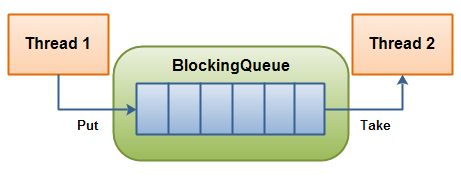本文主要讲的是并发包中涉及到的集合,关于普通集合,请参考【java 集合概览】
一、什么是blockingqueue
blockingqueue即阻塞队列,从阻塞这个词可以看出,在某些情况下对阻塞队列的访问可能会造成阻塞。被阻塞的情况主要有如下两种:
1. 当队列满了的时候进行入队列操作
2. 当队列空了的时候进行出队列操作
因此,当一个线程试图对一个已经满了的队列进行入队列操作时,它将会被阻塞,除非有另一个线程做了出队列操作;同样,当一个线程试图对一个空队列进行出队列操作时,它将会被阻塞,除非有另一个线程进行了入队列操作。
在java中,blockingqueue的接口位于java.util.concurrent 包中(在java5版本开始提供),由上面介绍的阻塞队列的特性可知,阻塞队列是线程安全的。
二、blockingqueue的用法
阻塞队列主要用在生产者/消费者的场景,下面这幅图展示了一个线程生产、一个线程消费的场景:

负责生产的线程不断的制造新对象并插入到阻塞队列中,直到达到这个队列的上限值。队列达到上限值之后生产线程将会被阻塞,直到消费的线程对这个队列进行消费。同理,负责消费的线程不断的从队列中消费对象,直到这个队列为空,当队列为空时,消费线程将会被阻塞,除非队列中有新的对象被插入。
三、blockingqueue接口中的方法
阻塞队列一共有四套方法分别用来进行insert、remove和examine,当每套方法对应的操作不能马上执行时会有不同的反应,下面这个表格就分类列出了这些方法:
| - | throws exception | special value | blocks | times out |
|---|---|---|---|---|
| insert | add(o) | offer(o) | put(o) | offer(o, timeout, timeunit) |
| remove | remove(o) | poll() | take() | poll(timeout, timeunit) |
| examine | element() | peek() |
这四套方法对应的特点分别是:
1. throwsexception:如果操作不能马上进行,则抛出异常
2. specialvalue:如果操作不能马上进行,将会返回一个特殊的值,一般是true或者false
3. blocks:如果操作不能马上进行,操作会被阻塞
4. timesout:如果操作不能马上进行,操作会被阻塞指定的时间,如果指定时间没执行,则返回一个特殊值,一般是true或者false
需要注意的是,我们不能向blockingqueue中插入null,否则会报nullpointerexception。
四、blockingqueue的实现类
blockingqueue只是java.util.concurrent包中的一个接口,而在具体使用时,我们用到的是它的实现类,当然这些实现类也位于java.util.concurrent包中。在java6中,blockingqueue的实现类主要有以下几种:
1. arrayblockingqueue
2. delayqueue
3. linkedblockingqueue
4. priorityblockingqueue
5. synchronousqueue
下面我们就分别介绍这几个实现类。
4.1 arrayblockingqueue
arrayblockingqueue是一个有边界的阻塞队列,它的内部实现是一个数组。有边界的意思是它的容量是有限的,我们必须在其初始化的时候指定它的容量大小,容量大小一旦指定就不可改变。
arrayblockingqueue是以先进先出的方式存储数据,最新插入的对象是尾部,最新移出的对象是头部。下面是一个初始化和使用arrayblockingqueue的例子:
|
1
2
3
|
blockingqueue queue = new arrayblockingqueue(1024);queue.put("1");object object = queue.take(); |
4.2 delayqueue
delayqueue阻塞的是其内部元素,delayqueue中的元素必须实现 java.util.concurrent.delayed接口,这个接口的定义非常简单:
|
1
2
3
|
public interface delayed extends comparable<delayed> {long getdelay(timeunit unit);} |
getdelay()方法的返回值就是队列元素被释放前的保持时间,如果返回0或者一个负值,就意味着该元素已经到期需要被释放,此时delayedqueue会通过其take()方法释放此对象。
从上面delayed 接口定义可以看到,它还继承了comparable接口,这是因为delayedqueue中的元素需要进行排序,一般情况,我们都是按元素过期时间的优先级进行排序。
例1:为一个对象指定过期时间
首先,我们先定义一个元素,这个元素要实现delayed接口
|
1
2
3
4
5
6
7
8
9
10
11
12
13
14
15
16
17
18
19
20
21
22
23
24
25
26
27
28
29
30
31
32
33
|
public class delayedelement implements delayed { private long expired; private long delay; private string name; delayedelement(string elementname, long delay) { this. name = elementname; this. delay= delay; expired = ( delay + system. currenttimemillis()); } @override public int compareto(delayed o) { delayedelement cached=(delayedelement) o; return cached.getexpired()> expired?1:-1; } @override public long getdelay(timeunit unit) { return ( expired - system. currenttimemillis()); } @override public string tostring() { return "delayedelement [delay=" + delay + ", name=" + name + "]"; } public long getexpired() { return expired; }} |
设置这个元素的过期时间为3s
|
1
2
3
4
5
6
7
8
9
|
public class delayqueueexample { public static void main(string[] args) throws interruptedexception { delayqueue<delayedelement> queue= new delayqueue<>(); delayedelement ele= new delayedelement( "cache 3 seconds",3000); queue.put( ele); system. out.println( queue.take()); }} |
运行这个main函数,我们可以发现,我们需要等待3s之后才会打印这个对象。
其实delayqueue应用场景很多,比如定时关闭连接、缓存对象,超时处理等各种场景,下面我们就拿学生考试为例让大家更深入的理解delayqueue的使用。
例2:把所有考试的学生看做是一个delayqueue,谁先做完题目释放谁
首先,我们构造一个学生对象
|
1
2
3
4
5
6
7
8
9
10
11
12
13
14
15
16
17
18
19
20
21
22
23
24
25
26
27
28
|
public class student implements runnable,delayed{ private string name; //姓名 private long costtime;//做试题的时间 private long finishedtime;//完成时间 public student(string name, long costtime) { this. name = name; this. costtime= costtime; finishedtime = costtime + system. currenttimemillis(); } @override public void run() { system. out.println( name + " 交卷,用时" + costtime /1000); } @override public long getdelay(timeunit unit) { return ( finishedtime - system. currenttimemillis()); } @override public int compareto(delayed o) { student other = (student) o; return costtime >= other. costtime?1:-1; }} |
然后在构造一个教师对象对学生进行考试
|
1
2
3
4
5
6
7
8
9
10
11
12
13
14
15
16
17
18
19
|
public class teacher { static final int student_size = 30; public static void main(string[] args) throws interruptedexception { random r = new random(); //把所有学生看做一个延迟队列 delayqueue<student> students = new delayqueue<student>(); //构造一个线程池用来让学生们“做作业” executorservice exec = executors.newfixedthreadpool(student_size); for ( int i = 0; i < student_size; i++) { //初始化学生的姓名和做题时间 students.put( new student( "学生" + (i + 1), 3000 + r.nextint(10000))); } //开始做题 while(! students.isempty()){ exec.execute( students.take()); } exec.shutdown(); }} |
我们看一下运行结果:
学生2 交卷,用时3
学生1 交卷,用时5
学生5 交卷,用时7
学生4 交卷,用时8
学生3 交卷,用时11
通过运行结果我们可以发现,每个学生在指定开始时间到达之后就会“交卷”(取决于getdelay()方法),并且是先做完的先交卷(取决于compareto()方法)。
通过查看其源码可以看到,delayqueue内部实现用的是priorityqueue和一个lock:

4.3 linkedblockingqueue
linkedblockingqueue阻塞队列大小的配置是可选的,如果我们初始化时指定一个大小,它就是有边界的,如果不指定,它就是无边界的。说是无边界,其实是采用了默认大小为integer.max_value的容量 。它的内部实现是一个链表。
和arrayblockingqueue一样,linkedblockingqueue 也是以先进先出的方式存储数据,最新插入的对象是尾部,最新移出的对象是头部。下面是一个初始化和使linkedblockingqueue的例子:
|
1
2
3
4
|
blockingqueue<string> unbounded = new linkedblockingqueue<string>();blockingqueue<string> bounded = new linkedblockingqueue<string>(1024);bounded.put("value");string value = bounded.take(); |
4.4 priorityblockingqueue
priorityblockingqueue是一个没有边界的队列,它的排序规则和 java.util.priorityqueue一样。需要注意,priorityblockingqueue中允许插入null对象。
所有插入priorityblockingqueue的对象必须实现 java.lang.comparable接口,队列优先级的排序规则就是按照我们对这个接口的实现来定义的。
另外,我们可以从priorityblockingqueue获得一个迭代器iterator,但这个迭代器并不保证按照优先级顺序进行迭代。
下面我们举个例子来说明一下,首先我们定义一个对象类型,这个对象需要实现comparable接口:
|
1
2
3
4
5
6
7
8
9
10
11
12
13
14
15
16
17
18
19
20
21
22
|
public class priorityelement implements comparable<priorityelement> {private int priority;//定义优先级priorityelement(int priority) { //初始化优先级 this.priority = priority;}@overridepublic int compareto(priorityelement o) { //按照优先级大小进行排序 return priority >= o.getpriority() ? 1 : -1;}public int getpriority() { return priority;}public void setpriority(int priority) { this.priority = priority;}@overridepublic string tostring() { return "priorityelement [priority=" + priority + "]";}} |
然后我们把这些元素随机设置优先级放入队列中
|
1
2
3
4
5
6
7
8
9
10
11
12
13
|
public class priorityblockingqueueexample {public static void main(string[] args) throws interruptedexception { priorityblockingqueue<priorityelement> queue = new priorityblockingqueue<>(); for (int i = 0; i < 5; i++) { random random=new random(); priorityelement ele = new priorityelement(random.nextint(10)); queue.put(ele); } while(!queue.isempty()){ system.out.println(queue.take()); }}} |
看一下运行结果:
priorityelement [priority=3]
priorityelement [priority=4]
priorityelement [priority=5]
priorityelement [priority=8]
priorityelement [priority=9]
4.5 synchronousqueue
synchronousqueue队列内部仅允许容纳一个元素。当一个线程插入一个元素后会被阻塞,除非这个元素被另一个线程消费。
以上就是本文的全部内容,希望对大家的学习有所帮助,也希望大家多多支持服务器之家。
原文链接:https://blog.csdn.net/suifeng3051/article/details/48807423















